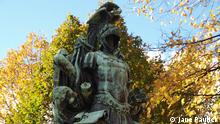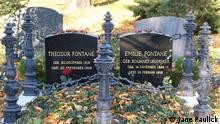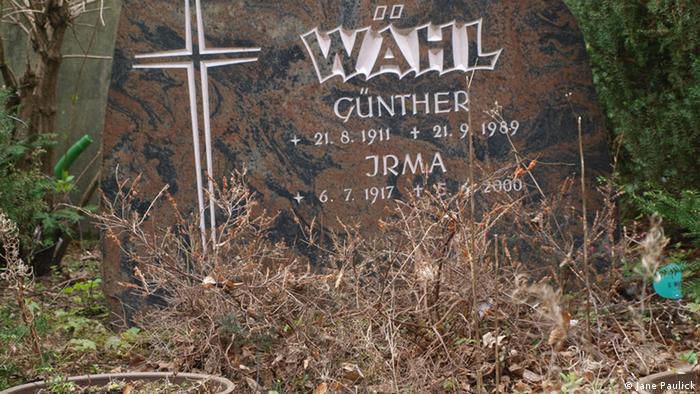Cemeteries are basically free outdoor museums, and Berlin has plenty to offer those with morbid curiosity. But as Jane Paulick finds out, graveyards are as much about the living as the dead.
I was first introduced to Berlin's many cemeteries by an old boyfriend of mine who'd once worked as a gravedigger in the former East Germany.
It was a popular line of work amongst refuseniks barred by the Communist state from studying or working in their chosen profession, he told me, while for their part, the authorities were happy to see troublemakers relegated to a place where their bad influence hardly mattered - the ultimate dead-end job, as it were.
The GDR wasn't too precious about its cemeteries in more ways than one. In 1961, it had no qualms about building the Berlin Wall through hallowed ground, including that of the landmark Invalidenfriedhof, where you can hobnob with the ghosts of Prussian generals.
The last time I was there, I overheard a tour guide telling a group of French teenagers how one third of the cemetery's headstones, attesting to 200 years of sepulchral culture, had been razed and replaced with a concrete strip lined with watch towers and searchlights.
Rest in peace - but not for long
 There's lots to explore in the overgrown wilderness of Berlin's cemeteries
There's lots to explore in the overgrown wilderness of Berlin's cemeteries
Berlin has some 230 graveyards comprising of almost 1,200 hectares of burial ground at its disposal, and they all have their own distinct character.
Less than a kilometer away from the Invalidenfriedhof is the more fortuitously positioned 18th century Dorotheenstadt Cemetery on Chaussestraße. Here, stray cats slink around with a proprietorial air and mulberry trees and sycamores cast shadows over the weathered graves of many a notable personage, from literary heavyweights Bertolt Brecht, Heinrich Mann and Christa Wolf to architect Karl Friedrich Schinkel and former president Johannes Rau.
But the first time I visited, I was mainly struck by the ugly white flags sticking up out of many of the ivy-shrouded plots like officious plastic sentinels. Stelle abgelaufen, they read, which basically means "time's up."
In Germany, death doesn't always mean eternal sleep. Cemetery plots are merely rented for 20 years and if family members want an extension, they have to cough up another installment. If they don't, the plot is recycled and a new occupant gets to move in. So much for respecting the dead.
Famous people, though, don't usually end up having to share their final resting place. The city pays for the upkeep of celebrity graves, and there are a fair few of them scattered around the capital.
The classiest of Berlin's cemeteries is probably the Städtischer Friedhof Schöneberg, where Marlene Dietrich and fashion photographer Helmut Newton are buried.
But the Berlin answer to Jim Morrison's grave in Père Lachaise in Paris is probably the tombstone of '60s icon and one-time Velvet Underground collaborator Nico, a few kilometers further west in the Grunewald Forest Cemetery.
To me, this is one of the spookiest of the city's graveyards. An overgrown wilderness on the outskirts of town, it was historically known as the Suicides' Cemetery due to its proximity to a bend in the River Havel where the bodies of people who'd taken their own lives in its murky depths often washed up.
Cemeteries for everyone
 Senate Administration wants to encourage the public to make the most of cemeteries as green spaces
Senate Administration wants to encourage the public to make the most of cemeteries as green spaces
Berlin's cemeteries reflect its long tradition of tolerance. There's even one for atheists, founded in 1847 in the neighborhood of Prenzlauer Berg. Reinvented as a park in the 1990s, these days it's teeming with trendy young mothers who flock with their toddlers to the playground on its eastern edge, at the opposite end to the inscription above the gate: Schafft hier das Leben gut und schön, kein Jenseits ist, kein Aufersteh'n, which roughly translates as: Enjoy life while you can; There is no afterlife, no resurrection. A pretty progressive thought for the mid-19th century.
There's a very different vibe over in the Jewish cemetery in the north-eastern district of Weissensee. One of the most hauntingly beautiful of the city's graveyards, it was submitted earlier this year for inclusion on UNESCO's list of World Heritage sites. Dating back to the 1880s, it is the largest Jewish cemetery in Europe still in use but serves mainly as the resting place for some 115,000 Jews who died prior to the Holocaust.
Further east in Lichtenberg, meanwhile, you can pay your respects to Karl Liebknecht and Rosa Luxemburg at the Socialists' Cemetery. Also known as the Friedrichsfelde Central Cemetery, it recently offered to help out when Berlin's Turkish community complained that by the end of 2012 it will have run out of burial space at the two cemeteries reserved for Muslims in the districts of Gatow and in Neukölln.
Green spaces
The rise in demand for alternatives to burial has in fact left Berlin's Christian graveyards with so much surplus space that in 2006, the local government approved a long-term development plan that foresees one third of the city's current burial grounds eventually used for other purposes.
"Along with their main role as places for burial, mourning and memorial, graveyards also function as places of relaxation and as natural biotopes," it says on the website of the Senate Administration for Urban Development, going on to encourage the public to make the most of them as green spaces.
I already do, and I'm the not the only one. My morning jogging route takes me through a cemetery in Pankow, where the air hums with birdsong all through the year. I've heard owls hooting there too, and a few weeks ago, I even saw a fox moseying along the uneven cobbled pathway.
As the 19th century novelist and poet Theodor Fontane once said: "Nothing is more alive than a cemetery." dw de


No comments:
Post a Comment